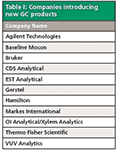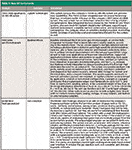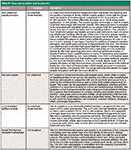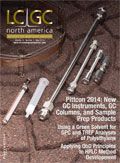New Gas Chromatography Products 2014
LCGC North America
A review of GC instruments and accessories that were new at Pittcon or introduced to the marketplace in the preceding year
In this "GC Connections" installment, I review gas chromatography (GC) instruments and accessories that were newly on display at the Pittsburgh Conference in March 2014, or were introduced to the marketplace in the preceding year.
The Pittsburgh Conference on Analytical Chemistry and Applied Spectroscopy (Pittcon) returned to Chicago's McCormick Place for its 65th annual meeting on March 2–6, 2014. This year, more than 16,200 conferees and exhibitor personnel attended Pittcon and the cohosted Food Labs Conference. More than 36% were listed as first-time attendees, but the published statistics did not differentiate between Pittcon and Food Labs registrants. The exposition floor sited 935 exhibitors in a total of 1763 booths; 32 countries were represented. As was the case in 2013 (in Philadelphia, Pennsylvania), the exhibition floor proved easier to navigate than in earlier conferences. This did not seem to be related to the size of the conference, which has not varied by more than about 10% in recent years, but rather the layout was well organized with many booths positioned in logical groups.

Table I: Companies introducing new GC products
The technical program was of high quality with 73 symposia, 10 awards, 84 oral sessions, plus posters and workshops making up a total of 2000 technical sessions. Emphasis was clearly on life science topics, which constituted 40% of the presentations. The short course program continued its high activity with 116 offerings.
Pittcon will journey to New Orleans, Louisiana, in 2015 — a welcome respite from two consecutive years in colder northern locations. Heading to Atlanta, Georgia, in 2016, conferees will now enjoy a couple years of Southern hospitality until the conference swings back to Chicago in 2017.

Table II: New GC instruments
This annual "GC Connections" installment reviews gas chromatography (GC) instrumentation and accessories shown at this year's Pittcon or introduced during the previous year. For a review of new GC and liquid chromatography (LC) columns and related accessories, please see "Column Watch" in the April and May 2014 (1,2) issues of LCGC North America, which are also available on-line at www.chromatographyonline.com/ColumnWatch.
The information presented here is based on manufacturers' replies to questionnaires, as well as on additional information from manufacturers' press releases, web sites, and product literature on the past year's products. It is not based on actual use or experience of the author. During Pittcon, I took time to stroll around the convention aisles and see some of the new products first-hand as well as to discover a number of items that weren't covered by the questionnaires. Every effort has been made to collect accurate information, but because of the preliminary nature of some of the material LCGC cannot be responsible for errors or omissions. This column installment cannot be considered a complete record of all new GC products introduced this year at Pittcon or elsewhere because not all manufacturers chose to respond to the questionnaire or attend the conference, nor is all of the submitted information necessarily included here because of the limited available space and the editors' judgment as to its suitability.

Table III: New autosamplers and accessories
Gas Chromatography at Pittcon 2014
GC again displayed renewed vigor at this year's Pittcon technical sessions. As in previous years, work in comprehensive GC×GC continues to yield significant advances, while the older technique of moving thermal-gradient GC (TGGC) is finding a new niche. Of particular interest were two contributions in separate sessions by members of Milton Lee's group from Brigham Young University on the theory and practical applications of TGGC for microfabricated GC and for GC×GC (3,4) Originally investigated decades ago, TGGC helps focus and control the passage of analytes through a column to produce improved temperature-programmed separations. While the technique has not been adopted for commercialization in recent years, perhaps a new TGGC instrument will appear sometime in the future.
Two other GC topics stood out: alternative carrier gases and ionic liquid phases for GC. With the continuing uncertainty that surrounds helium supplies, the use of hydrogen or nitrogen as alternatives still garners much attention. Interest in hydrogen was evident throughout the exhibition as well as in a number of papers and posters. Recent developments seem to indicate that new supplies of helium from areas such as Qatar will ensure availability for the foreseeable future, but prices may remain high. Ionic liquid GC phases provide some unique selectivities and interest remains strong while applications of these materials expand to liquid–liquid and solid-phase micoextraction. See the related article on chromatography columns at Pittcon 2014 (2) for more details.

Table IV: New GC instrument accessories
In the product realm, there were a few GC instruments introduced since Pittcon 2013. From Agilent Technologies, introduced at ASMS in 2013, the model 7000C triple-quadrupole GC–MS-MS system represents the high end of GC-MS with its advanced spectrometric capabilities and high sensitivity. During the past year, Agilent also introduced a hydrogen sensor and a large heated valve oven for its model 7890B GC system.
The 9100 Series gas chromatograph from Baseline Mocon is an on-line instrum ent that is reported to achieve laboratory-quality analysis for gas analysis across a wide range of applications. The model 5500 Fixed Gas Analyzer from CDS Analytical is an adjunct to the company's trapping pyrolysis systems for the analysis of low-molecular-weight gaseous by-products.
Bruker showed the GC-APCI II GC–MS interface, which can be combined with any Bruker ESI mass spectrometer, including the impact HD LC-QTOF system introduced at the 2013 ASMS conference. The interface makes the impact HD's unique LC–QTOF-MS capabilities — such as accurate mass screening or determination of elemental compositions — accessible for GC–QTOF-MS.
Markes International's Select-eV variable-energy ion-source technology for GC–MS allows the energy used for electron ionization to be changed on a sliding scale without loss of sensitivity. This allows the production of both classical mass spectra and repeatable soft-ionization spectra with reduced fragmentation and an enhanced molecular ion.
VUV Analytics displayed a new type of GC detector that collects vacuum-ultraviolet spectra of peaks as they are eluted for peak identification, deconvolution, and selectivity. The detector operates from ~120 to 240 nm, down to shorter wavelengths than the ~190-nm capability of routine diode-array LC detectors.
A number of autosamplers and related devices debuted this year. The model 4100 Water/Soil sample processor from OI Analytical automates the handling and processing of samples in up to 100 40-mL volatile organic analysis (VOA) vials for purge-and-trap analysis in conjunction with one or two of the company's Eclipse purge-and-trap instruments. The sample processor is equipped with a unique pneumatically actuated cylindrical vial gripper. Also from OI Analytical, the model LV-20 standards addition module is an option for the company's model 4551A water autosampler. The standards addition module adds internal standards, surrogate, or matrix spike standards for GC and GC–MS analyses.
The Flex autosampler from EST Analytical can perform a wide variety of liquid injections as well as some basic sample preparation on-board. This system can be upgraded to perform headspace sampling as well. And from CDS Analytical, the model 7500 thermal desorption autosampler is an extension of the company's model 7400 purge-and-trap system that offers the ability for the user to change between air-sample thermal desorption (TD) tubes and VOA vials for soil or water analysis.
Thermo Scientific's programmable Virtuoso vial printing system prints indelible, detailed information directly on sample vials in three text fields with a mini quick response (QR) barcode. Vial labeling takes approximately 5 s and the identification data can be input using the unit's touchscreen or directly from the lab network.
Gerstel's Hot Injection and Trapping (HIT) technique combines analytes from several headspace injections in a trapping or desorption procedure for single GC–MS runs. The technique integrates the capabilities of the company's MultiPurpose Sampler (MPS), Thermal Desorption Unit (TDU), and Cooled Injection System (CIS) inlet.
From Hamilton, the new S-line syringe for CTC PAL Autosampler applications complements the company's existing C-Line and X-Type CTC PAL autosampler syringes. S-Line syringes are built for economic everyday use for GC and high performance liquid chromatography (HPLC) injection applications.
Acknowledgments
I would like to thank the manufacturers and distributors that kindly furnished the requested information, which allowed a timely report on new product introductions over the past year. For those manufacturers who did not receive a preconference questionnaire this year and would like to receive one and be considered for early inclusion into the 2014–2015 new GC and related product introductions review, please send the name of the primary company contact, the mailing address, fax number, and e-mail address to Laura Bush, Editorial Director, LCGC and Spectroscopy, lbush@advanstar.com, Attn: 2015 New GC Products.
References
(1) R. Majors, LCGC North Am.32(4), 242–255 (2014).
(2) R. Majors, LCGC North Am.32(5), 316–327 (2014).
(3) H.D. Tolley, S.E. Tolley, A. Wang, M.C. Asplund, and M.L. Lee, "Properties of Thermal Gradient GC Separations," presented at the Pittsburgh Conference on Analytical Chemistry and Applied Spectroscopy (Pittcon 2014), Chicago, Illinois, 2014.
(4) A. Wang, A.R. Hawkins, H.D. Tolley, and M.L. Lee, "Enhancing Separation Performance of Microfabricated Gas Chromatography Using Temperature Gradients," presented at the Pittsburgh Conference on Analytical Chemistry and Applied Spectroscopy (Pittcon 2014), Chicago, Illinois, 2014.
John V. Hinshaw "GC Connections" editor John V. Hinshaw is a Senior Scientist at Serveron Corporation in Beaverton, Oregon, and a member of LCGC's editorial advisory board. Direct correspondence about this column to the author via e-mail: lcgcedit@lcgcmag.com.

John V. Hinshaw

Study Examines Impact of Zwitterionic Liquid Structures on Volatile Carboxylic Acid Separation in GC
March 28th 2025Iowa State University researchers evaluated imidazolium-based ZILs with sulfonate and triflimide anions to understand the influence of ZILs’ chemical structures on polar analyte separation.
Quantifying Microplastics in Meconium Samples Using Pyrolysis–GC-MS
March 26th 2025Using pyrolysis-gas chromatography and mass spectrometry, scientists from Fudan University and the Putuo District Center for Disease Control and Prevention detected and quantified microplastics in newborn stool samples.













